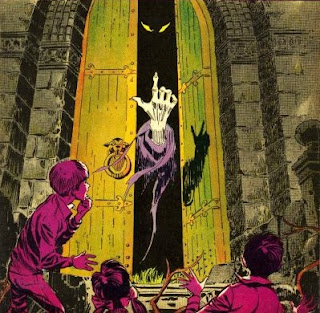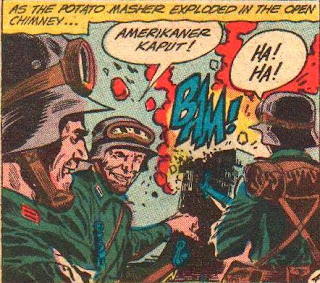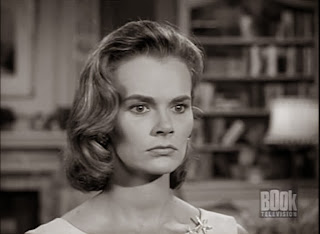The DC Mystery Line 1968-1976
by Jack Seabrook,
John Scoleri,
 |
| Neal Adams |
House of Mystery 192 (June 1971)
"The Gardener of Eden!"
Story by John Albano
Art by Jim Aparo
"Image of Darkness"
Story by Bob Kanigher
Art by Gray Morrow
"Nobody Loves a Lizard!"
Story by Virgil North
Art by Don Heck
Peter: Doctor Adam Eden (you heard me) and his beautiful wife, Eve (yep!) move into their brand new mansion, only to find it already inhabited by a slow-witted hunchback named Boris. The doctor tells Boris to get out immediately but his wife takes pity on the malformed dimwit and hires him on as the "Gardener of Eden." After a few weeks, the doctor notices Eve enjoying quite a bit of time with his new employee and decides to bury the hatchet... in Boris's skull. Eve confronts her murderous husband and tells him she's never loved anyone but him. Ashamed of his rash act of violence, the doc decides to make Boris the recipient of a new synthetic brain he's been working on.

The experiment a success, the exhausted surgeon hits the sack, only to wake later to find himself strapped to a gurney and prepped for surgery. Boris has relieved Eve of her maiden brain and replaced it with a similar plastic one and is now about to do the same for Adam. John Albano had obviously been watching a lot of late night horror movies as he hits every brain transplant cliche right on the head. Why the dopey doc would want to put a super-high-intelligent brain into a man he'd just tried to kill is not really explored. Nor is the very fast transformation Adam has from respectable doctor who ignores his wife most of the time to jealous, salivating murderer. Jim Aparo does his best with what little he has to work with (I picture the story notes something like "Boris is a big, ugly hunchback") and at least we've got that fabulous Neal Adams cover. Do you think Neal would have liked to read one of these scripts that actually involved kids in danger?
Jack: I thought it was kind of rude of Dr. Eden to make a snap judgment that Boris must be retarded and then hand him a wad of cash and tell him to go live somewhere else. We are told that Dr. Eden is "usually charitable," but he sure acts like a jerk. Fortunately, the always-reliable Jim Aparo makes this ridiculous story nice to look at. And what exactly is a plastic brain?
John: There's something particularly odd and yet creepy about the way Aparo drew Boris. Thankfully, the depiction really helps the story.

Peter: 19th Century Andrew's got a problem: he's a really ugly, malformed hunchback with bad teeth (think, I don't know, Boris from the last story), but things may be looking up. He's found a mirror that transforms him (in his words) into a "Young... Handsome (and) straight" man. Setting aside his preference for men, Andrew travels through the mirror into our present day and falls in love with beautiful Susan. They take up residence at the House of Mystery and all seems wonderful until he discovers that he has to go back through the mirror every night at midnight or face transforming into the ugly princess before Susan's eyes. Susan puts up with it at first but then has her suspicions until one night she witnesses Andrew changing back into Boris. End of story. I've dozed through probably half a dozen Robert Kanigher horror stories and not one of them is half as good as the worst Kanigher war story I've read. There's some confusion here as to how much time elapses between the day Andrew heads through the mirror and the first night he discovers the drawback to his paradise. The guy does all kinds of interesting things, hits parties, discos, night clubs and meets and woos Susan and convinces her to live with him. Did this all happen in one day? How could he not have known he'd turn back into his old creepy self? Was he drunk all those nights? The Morrow art is steadily declining, going from what I once thought of as stylish to a more by-the-numbers look. One more thing: this gimmick of Cain popping up as a character in these stories doesn't make sense. Granted, Andrew is a supernatural presence but Susan seems to be a nice lass. Doesn't she think it's weird that Andrew has no visible means of support and they're living in the House of Mystery with a graveyard caretaker?
Jack: I'm surprised at your negative reaction to this story. I thought the story was decent, until the corny ending, and I liked Gray Morrow's art better than I've liked it in other stories recently. I thought it was nice how he was starting to get away from the overly freaky designs and just draw characters and scenes a little bit more realistically. I even liked his depiction of the swingin' seventies lifestyle. I'll admit it's a little jarring to go from a Jim Aparo Cain in the first story to a Gray Morrow Cain in the second story, especially since Morrow's version of the caretaker looks like a college professor. By the way, while we all know it's really the House of Mystery, Andrew refers to it as the House of Cain.

Peter: "Nobody Loves a Lizard" is a four page piece of fluff about an orphan, constantly berated by the orphanage director, who has a fondness for reptiles. All ends happily when he's adopted by a beautiful lady with a giant tail. Don Heck's art here is actually palatable and the story, such as it is, is pretty harmless. By default, "Lizard" is the best story in the issue and that's not much of an endorsement.
Jack: I liked "Image of Darkness" better but I agree that this is above average art from Don Heck. It doesn't make much sense as a story but I like the talking lizard. Little known fact: this was the first credit (per IMDB) for the diminutive actor who would later go on to work for GEICO.
John: Better than a Humpty Dumpty appearance, for what it's worth.
 |
| Berni Wrightson |
House of Secrets 92 (July 1971)
"Swamp Thing"
Story by Len Wein
Art by Berni Wrightson
"After I Die!"
Story by Jack Kirby and Mark Evanier
Art by Bill Draut
"It's Better to Give..."
Story by Virgil North
Art by Alan Weiss and Tony deZuniga
Peter: History (and
some of the creators involved) tell us that it was simply a coincidence that Man-Thing and Swamp Thing appeared on the newsstand virtually at the same time. Len Wein wrote "Swamp Thing" (introducing a quite dissimilar character than the one who would later garner his own title), then took a taxi over to Marvel, where he wrote an installment of the Man-Thing series (originally slated for
Savage Tales #2 but eventually surfacing in
Astonishing Tales #12, June 1972), and then basically re-wrote the
House of Secrets short, mixing in some very similar elements from the Marvel series. Way too close, says Roy Thomas in an interview in
Alter Ego #81: "Gerry and I thought that, unconsciously, the origin in
Swamp Thing #1 was a bit too similar to the origin of Man-Thing a year-and-a-half earlier. There was vague talk at the time around Marvel of legal action, but it was never really pursued... We weren't happy with the situation over the
Swamp Thing #1 origin, but we figured it was an accident. Gerry was rooming with Len at the time and tried to talk him into changing the Swamp Thing's origin.

Len didn't see the similarities, so he went ahead with what he was going to do." Roy goes on to say that
his monster was a knock-off of the Heap, a swamp creature that had a back-up strip in
Airboy Comics during the 1940s. In any event, this particular issue of
HoS quickly became sought after on the collector's market, and one of the most expensive single issues in the entire mystery line. So what about the story itself? It's a bit different than the origin story related in
Swamp Thing #1 (which is more of a reboot of the short story) but the skeleton remains the same: Alex Olsen (later rechristened Alec Holland) and his partner, Damian Ridge, are dabbling in some sort of chemistry (the formula the pair are working on is not the only vague plot point in this story--the characters are dressed in what appears to be 19th Century clothing) in a huge estate on the edge of a swamp.
Unbeknownst to Alex, Damian secretly covets his partner's wife, Linda, and rigs the laboratory equipment to explode while Alex is working. Damian tells Linda that Alex is dead and then buries the man (alive) in the swamp. Linda and Damian soon marry but it's a strained relationship. Believing that his new wife is suspicious of his friend's death, Damian decides to off her but Alex, now risen as swamp monster, arrives in the nick of time and gets his revenge. The obvious highlight here is Bernie Wrightson's dark, moody art but Wein's simple story works well enough that we empathize with seven feet of moss and muck. Even if this story had not spawned the multi-armed Swamp Thing franchise, this would still have been one of the best, most atmospheric short stories DC ever ran in their mystery line.

Jack: I completely agree. This is a great story! Going back a little further than the Heap, this story has its origin (whether Wein recalled it or not) in Theodore Sturgeon's "It," published in the August 1940 issue of the pulp,
Unknown. The monster in that story is also risen from a dead man's body in a swamp, though Wein and Wrightson bring a lot more humanity and pathos to their character. The DC Comics Database, which usually has less information than the Grand Comics Database, notes that Wrightson used Mike Kaluta as his cover model for Swampy and Louise Jones as his cover model for Linda. Louise Jones was married to Jeff Jones, but later married Walt Simonson.
John: A great story, worthy of its classic status, but honestly not Wrightson's best work, in my opinion.
 |
The rest of this script maybe?
|
Peter: Maxwell James becomes obsessed with the "beyond" after watching his wife's reaction just before death. When legitimate doorways are blocked, James decides to kill his freeloader brother-in-law and extract the secret as the man fades away. Not being an expert with a gun, things go backasswards for Maxwell and it's he who takes a bullet. As he dies, he pleads with his wretched in-law to look into his eyes. The man does so and the truth sends him swirling into insanity. There's nothing wrong with not having a character to root for but the story meanders and see-saws so much you give up trying to figure out the point of it all. Proof that Jack Kirby's best writing involved superheroes fighting cosmic menaces. Another really bad tale that looks as though it's been in a file folder for 15 years and missed its on-sale date. There's a reason for that... In a fascinating piece in
The Jack Kirby Collector #40 (mostly given over to a discussion on the birth of Kirby's
Kamandi), Mark Evanier relates how "After I Die" came about. It was based on a story written by Kirby and Joe Simon for one of DC's early anthology books,
Black Magic, and resurrected by Kirby when Carmine Infantino asked "The King" to help boost the flagging mystery line. Kirby handed the original story over to Evanier and told him to "rewrite and modernize" it but, when Jack got Evanier's script, he didn't care for it and rewrote the whole thing. When the story was about to run, Evanier was so unhappy about the experience that he requested the story run without his byline. I'd have done the same.
Jack: Oddly enough, the story ran without any credits at all. One would think they would have wanted to promote Kirby's involvement. I did not mind the story as much as you did, possibly because I was so elated from reading "Swamp Thing" that I gave this a pass. I will say that the brother-in-law, Hal, looks much too young.
John: If you hadn't pointed out it was Kirby, I think I would have read it and moved along, without even realizing it.

Peter: Smilin' Sam, a hobo, discovers a crying child in the junkyard he lives in and helps the little runt. Suddenly, his luck turns good and he discovers a veritable money machine: a faucet that spits out dimes. When another vagrant gets wind of this, he murders Sam but then has to face the wrath of the little boy, who's come back to visit Sam. Yet another of those yarns that either has you scratching your head or burning the comic book in disgust (since this particular issue is worth so much, I'd vote the former). Who exactly is this little kid and when he exacts revenge for Sam by absorbing the man into a balloon and popping it, does the bum explode as well or what? I have no idea! The murderous "bum" by the way looks like a dock worker rather than a "malicious tramp." The final two pages are given over to a short-short called "Trick or Treat," of which the less said the better.
John: I thought the balloon popping was a cool idea.
Jack: I guess I was on such a high from "Swamp Thing" that I liked all of the stories in this issue! The kid turns out to have been a baby warlock, according to Abel. He would later grow up to star in a Marvel series of his own but he had absolutely nothing to do with Jeff Jones.
 |
| Nick Cardy |
Unexpected 125 (July 1971)
"Screech of Guilt!"
Story by Jack Phillips (George Kashdan)
Art by Art Saaf
"Escape Into the Unknown!"
Story by Carl Wessler
Art by Sid Greene
"Know No Evil!"
Story by George Kashdan
Art by Jerry Grandenetti
Jack: Nicholas shoots and kills his business partner, Clinton, after the man discovers that he has been embezzling from the company coffers. Clinton's pet parrot heard the whole thing and with a "Screech of Guilt!" squawks out the final verbal exchange between the two men. Nicholas tries to kill the bird but it escapes. It then follows him, driving him slowly crazy until he is attacked and killed by a company of parrots at a bird sanctuary. They should have called this story "The Tell-Tale Parrot." The art isn't half-bad for an issue of
Unexpected but the story is predictable.
 |
This is why you're not supposed to get out
of your car at the drive-through Jungle Safari Park |
Peter: A completely ludicrous story that I still managed to enjoy for some reason. This parrot has got to be the most intelligent creature in the solar system. He not only memorizes and apes the entire conversation held during the murder but then knows when to keep his beak shut (why he doesn’t say anything in front of Martha is anyone’s guess). The finale brings up an interesting question: did Polly the bird plan the murder of Nicholas? How would the parrot know that Nicholas would take that highway (through the Parrot Jungle!!!) and release him in just the right spot? Did the bird set up Nicholas’s murder with all his parrot friends ahead of time? I can just see the “director’s cut” version of this story where all the parrots are in a circle while Polly maps out the plan: “Rawwwk, okay he’ll release me here and I’ll fly in and we’ll all shout the speech we’ve been practicing and then we’ll tear him to ribbons with our little beaks!” Yep, too much time spent on something that should have been rejected at the editor’s table as “simply too stupid” but I think this is one of those rare “birds”: the story so outlandish, so inane, so completely devoid of quality, that it becomes entertainment.
John: Okay, I figured you guys were talking up an issue of Unexpected to get me to give it another chance. I'll be darned if this isn't the most entertaining tales to come out of these pages. That said, I'm still not ready to give Unexpected another chance.

Jack: On the run after a prison break, Lefty climbs the scaffolding of a rocket ship about to take off and hides inside. In an "Escape into the Unknown!" he finds himself launched into space, alone. He begins to hallucinate as time passes until finally the satellite returns to Earth and Lefty emerges--sporting long, gray hair and looking decades older. He escaped a life sentence in prison only to spend 48 years alone in space! Another fairly predictable story, though well-executed. I did not expect the Rip Van Winkle conclusion.
Peter: The set-up is pretty lame (security is hilariously bad at this rocket launch and I'm not sure the scientists would launch a rocket knowing there was an ex-con hiding somewhere on the base) and the pay-off is tired but the story’s pretty harmless. Sid Greene’s art resembles that of a reined-in Jerry Grandenetti. The edges are still a bit rough but it’s not as exaggerated.
Jack: Ferghol tells Mr. Barnes that sniffing the fumes from some weird, rare flowers will transfer the evil parts of his personality into a horrible creature named Amram for 24 hours and allow Mr. Barnes to commit any crimes he chooses. The authorities will "Know No Evil!" attaches to Barnes because all of the evil will be with Amram. Barnes successfully carries out a string of robberies, but the spell only lasts 24 hours. He sneaks a look at Amram, who is grotesque, having taken onto his body the effects of all of the crimes done by other men. When Barnes is dying, after having been hit by a truck, he confesses the truth, and his confession reverses the effect on poor Amram. Amram wants to find the other criminals whose evil deeds have been loaded onto him and get them to confess, but Ferghol stands in his way, so Ferghol is killed trying to prevent Amram from finding peace. Amram goes to the police and ends up in the courtroom of Judge Gallows, who believes his story. This supposed miscarriage of justice is one of the events that leads Judge Gallows to be removed from the bench. Meanwhile poor Amram waits for criminals to confess and return him to health. Whew! Hard to believe they fit all of that into eight pages. Believe it or not, the cool Nick Cardy cover of this issue is an "interpretation" of an event from this story. Jerry Grandenetti's art is bearable for a change.

Peter: I’d have liked to see more of the trial (I mean, you’ve got this eerie judge, why not use him?) but this was certainly better than the other Judge Gallows stories we’ve been subjected to. The empath idea is a sophisticated one and I’m fairly sure it was lost on most of the ten year-olds who might have picked the issue up, but I certainly applaud writer George Kashdan for attempting something a little more adult than haunted mirrors and cursed felines. The real Jerry Grandenetti (as opposed to his twin, Sid Greene) turns in an acceptable art job as well.
By the way, a letter from Ted Moynihan on the Unexpected Mail page reminds us we forgot to mention a couple of
Super DC Giants published in late 1970 and early 1971 that concern us around this blog.
Super DC Giant was a 68-page special that was published sporadically beginning in October 1970, with 15 issues appearing through Summer 1976. The numbering was funky but number S-20 (actually the 8th issue) was a special
House of Mystery issue. That issue reprinted:
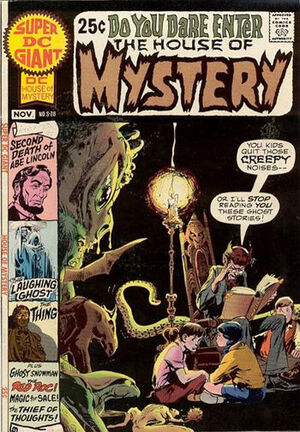
1/Black Magic for Sale (from
HOM #46, January 1956)
2/The Second Death of Abraham Lincoln (from
HOM #51, June 1956)
3/The Thing in the Box (from
HOM #61, April 1957)
4/The Laughing Ghost of Warwick Castle (from
HOM #56, November 1956)
5/Riddle of the Red Roc (from
HOM #63, June 1957)
6/The Lady and the Creature (from
HOM #63, June 1957)
7/The Thief of Thoughts (from
HOM #66, September 1957)
8/The Ghost Snowman (from
Sensation Mystery #114, April 1953)
3, 5, and 7 feature art by Jack Kirby while 8 is drawn by
Mad (and Mademoiselle Marie) legend Mort Drucker. Jack Sparling provided a new framing sequence for the reprints.
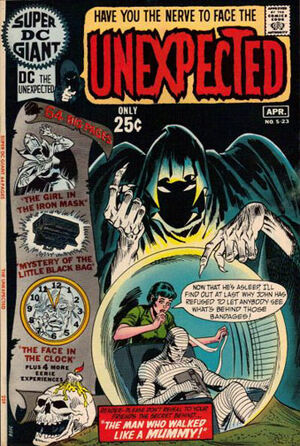 Super DC Giant
Super DC Giant #s-23 was a special
Unexpected number, reprinting:
1/The Demon in the Mirror! (from
Sensation Comics #109, June 1952)
2/The Man Who Walked Like a Mummy! (from
HOM #48, March 1956)
3/The Thing from the Skies (from
Tales of the Unexpected #13, May 1957)
4/The Face in the Clock (from
TOTU #14, June 1957)
5/Captives of Creature Castle (from
HOM #104, November 1960)
6/The Secret of the Little Black Bag! (from
HOM #9, December 1952)
7/The Girl in the Iron Mask (from
HOM #66, September 1957)
On that same Unexpected Mail page, editor Murray Boltinoff gives us the wonderful news that the title has been promoted to monthly status. Oh happy day!
 |
| Nick Cardy |
The Witching Hour 15 (July 1971)
"Freddy is Another Name for Fear!"
Story by George Kashdan
Art by Wally Wood
"Bayou Witch"
Story by Phil Seuling
Art by Gray Morrow
"I Married a Ghost"
Story by Al Case (Murray Boltinoff)
Art by Art Saaf
Jack: Oversized simpleton Freddy ("Freddy is Another Name for Fear!") has wrecked another dormitory and can't be trusted anywhere but in the home of Dr. Sherman, who tells young colleague Dr. Barnes that he's sure he can cure the big lummox. A ghostly figure appears at Freddy's window to tempt him to escape, but Freddy keeps his promise not to try and tells Dr. Sherman about it. What Freddy does not know is that Dr. Sherman plans to use his patient to kill ambitious young Dr. Barnes. Turnabout is fair play when Barnes has Freddy kill Sherman and Freddy then kills Barnes too for good measure. George Kashdan's script is terrible and Wally Wood's art is below average for the great Mr. Wood. There are atmospheric panels here and there but even he couldn't do much with this story.
 |
| "Freddy is Another Name for Fear!" |
Peter: This works up to a twist ending that never happens, a whimper rather than a bang. Wood’s art is weak, not up to the legendary work he’d presented innumerable times before. If I didn’t know better I’d say an inker muted Wally’s style but Wood did his own inking on “Freddy.” The reveal of the fake spectre outside Freddy's window is laugh out loud stupid.
John: Fortunately Wood left much better stuff for us to remember him by.
 |
| "Bayou Witch" |
Jack: When Heck Belleau claims Old Yeller Maggie is a "Bayou Witch," the backwoods folk turn on her and their luck becomes all bad. They head out with a lynching party but instead of the witch, they try to lynch Heck, until Maggie puts a stop to it. This dreadful story is told in rhymed stanzas in captions with no word balloons, which is a good thing because they would get in the way of Gray Morrow's art. Phil Seuling was a comic dealer who basically started the big Comic Con movement that led, decades later to the current annual behemoth in San Diego. As a writer, he makes a great salesman.
Peter: I think you're being a bit hard on this one, Jack, but it may be because I'm starving for something that's not horrible. Nice EC-ish art by Morrow (much better than the work he did on "Image of Darkness" in
HoM #192) highlights an awkwardly-phrased horror poem. I’m sure pop singer Jim Stafford read this story just before writing his own ballad to a “Swamp Witch.” The DC writers had a thing for backwoods escapades and swamp creatures, didn’t they?
John: Did anyone else think that the art really suffers in the reproduction here? I'd love to get a glimpse of the originals, which I imagine must have looked pretty sharp.
Jack: A slight glitch occurs with Gil and Jennifer's wedding plans the night before the big event. Gil drives carelessly on a rain-s
licked road and Jen dies in the crash. She returns lickety split as a ghost and Gil is so excited that, within hours, he is able to announce that "I Married a Ghost." Everyone thinks he's nuts but he insists that he's sharing his happy home with the late Jennifer. His friend Jack plays along until Gil almost dies from gas poisoning that may have been caused by his ghostly wife, whom Jack thinks wants Gil to hurry up and join her in the spirit world. Jack has a doctor come and take Gil away but Jack wonders if he may be falling under Jen's spell. A lackluster issue of The Witching Hour closes with this dud of a story, where the bad art more than matches the weak tale.
 |
| "I Married a Ghost" |
Peter: I sure wish I was old enough to have written comic books in 1971. Judging by this story, anyone could land a job at DC. You certainly didn’t need to be talented. Another story that ostensibly builds to a twist climax but leaves me wondering why they bother in the first place. Last issue’s trips to the science fiction well brought up some good bucketfuls but perhaps editor Murray Boltinoff wasn’t willing to commit to a radical change. An sf comic book titled
The Witching Hour probably would have confused all the ten year-olds anyway.
John: Another story bettered by the Nick Cardy cover art. On the bright side, Swamp Thing proves that every once and a while, something good will crawl out of the dreck...
We somehow managed to forget our time-honored tradition of picking the best and worst stories of the year so we'll kind of make up for that here. The following are our picks for the Best and Worst Script, Art and All-Around Story for the first 3 years we've covered:
Peter
Best Script: Jack Oleck, "Nightmare" (House of Mystery 186)
Best Art: Neal Adams, "Nightmare"
Best All-Around Story: "Nightmare"
Worst Script: Steve Skeates, "Strain" (House of Secrets 86)
Worst Art: Mike Roy/Mike Peppe, "A Face in the Crowd" (The Witching Hour 6)
Worst All-Around Story: Carl Wessler/Ed Robbins, "Diary of a Madman" (Unexpected 115)
Jack
Best Script: Jack Oleck, "Nightmare" (House of Mystery 186)
Best Art: Al Williamson, "The Beautiful Beast" (House of Mystery 185)
Best All-Around Story: Gil Kane/Wally Wood, "Comes a Warrior" (House of Mystery 180)
Worst Script: George Kashdan, "The Phantom of the Woodstock Festival" (Unexpected 122)
Worst Art: Jerry Grandenetti, "These Walls Shall Be Your Grave" (Unexpected 124)
Worst All-Around Story: Sam Glanzman, "
Please, Don't Cry, Johnny"" (
House of Secrets 91)
John
Best Script: Jack Oleck, "Nightmare" (House of Mystery 186)
Best Art: Sergio Aragones, for his always reliable contributions
Best All-Around Story: "Nightmare" (House of Mystery 186)
Worst Script: I chose to bestow this honor to Unexpected
Worst Art: Alex Toth, "ComputERR" (Witching House 8)
 Fortified by liquor, Lottie Mead takes a taxi to Queens, where she visits Artie Birdwell and his wife. Their daughter Eileen is at school and the Birdwells are uncomfortable with their visitor. Seven years before, they had paid Lottie to let them have the daughter she was ready to abandon and they went on to raise her as their own. Now Lottie wants her daughter back, or at least a weekly stipend. The Birdwells throw her out and she tries but fails to find a lawyer until, a week later, Phil Ames appears on her doorstep and offers to help. He recommends that she kidnap the child, insisting that the law will be on her side once she produces a birth certificate that proves she is the real mother.
Fortified by liquor, Lottie Mead takes a taxi to Queens, where she visits Artie Birdwell and his wife. Their daughter Eileen is at school and the Birdwells are uncomfortable with their visitor. Seven years before, they had paid Lottie to let them have the daughter she was ready to abandon and they went on to raise her as their own. Now Lottie wants her daughter back, or at least a weekly stipend. The Birdwells throw her out and she tries but fails to find a lawyer until, a week later, Phil Ames appears on her doorstep and offers to help. He recommends that she kidnap the child, insisting that the law will be on her side once she produces a birth certificate that proves she is the real mother.







